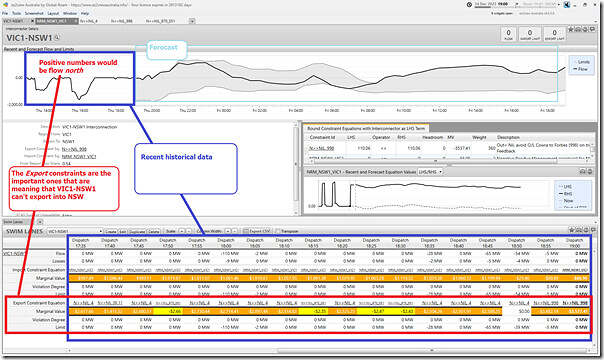KME’s added this comment to an earlier article where he says:
‘You can also see in this screenshot the VIC-NSW interconnector running counter-price. It’s been doing that all day – I saw over 1GW of counter-price flow earlier – with intervening periods of constraint when the NRM_NSW1_VIC1 constraint set has been invoked due to the accumulation of negative settlement residues.
I am not sure the costs of inadequate transmission from Wagga north-eastward are being accurately captured. Possibly (probably?) the need to activate RERT today would have been avoided if that south-westerly generation was available to the Sydney load centre.’
It’s worth adding in this snapshot here from ez2view that combines two widgets:
1) The ‘Interconnector Details’ widget, which we’ve used in articles here a number of times; but also
2) The ‘Swim Lanes’ widget that we’ve not used as frequently.
The top widget shows history and forecast data, and highlights that (remembering positive Target Flow is flow north from VIC to NSW) the interconnector’s not been allowed to flow north at all over the past 6 hours.
The bottom widget allows for a more granular tabular history for every Dispatch Interval … remembering that north is export:
1) There are a range of constraint equations that have bound in different dispatch intervals, restricting VIC1-NSW1 such that it cannot flow north.
(a) Recently Allan O’Neil wrote the useful explanation ‘What’s happening at Wagga?’ about this type of phenomenon.
(b) Allan’s article contains a table listing a number of different constraint equations … just in the window above we can see the effect of several:
i. The ‘N>>NIL_970_051’ constraint equation … such as at 17:50;
ii. The ‘N>>NIL_4’ constraint equation; and
iii. The ‘N>>NIL_998’ constraint equation.
iv. Plus perhaps more (I’ve not looked comprehensively).
… each for slightly different purposes, but all of them (on these occasions) meaning VIC can’t export to NSW.
2) The negative residue constraint which Kevin notes is (on occasions) limiting the flow south so that VIC1-NSW1 can’t flow south either
… such as in the 17:50 dispatch interval noted here.



It seems these constraints in southern NSW have reduced flow in both directions in the past. I seem to remember when supplies in Victoria were very tight that there was no flow from NSW. Maybe Transgrid should concentrate on fixing those issues rather than splurging on VNIWest and even perhaps Humelink
I would say that rather than being “disallowed”, what was happening here was simply a case of insufficient transmission capacity between the Snowy region and Sydney to carry all the available southern NSW generation + additional flows from Victoria. Once Snowy bid in its 2400+ MW from Lower and Upper Tumut, Origin 400+ MW at Uranquinty, plus hundreds of MW of solar generating in the area, there was no northward transmission capacity left to carry anything from Victoria. The N>>NIL_4 constraint (on one of the 330kV lines out of Yass) bound solidly, implying that any MW from Vic would have been at the expense of a matching quantity from a southern NSW generator – a zero sum game.
The only fix for this sort of limitation is augmentation of the main Snowy to Sydney flow path.
From the previous article on the issue, it sounds like there is additional transmission capacity that can’t be used due to the risk of a trip on one of the 500kV lines. Should this occur the “excess” energy would flow into the 330kV lines, which wouldn’t end well.
I suspect that the installation of a utility scale battery of sufficient capacity to provide fail over capacity should the 500kV line trip, would unleash additional transmission capacity. The Victorian Big Battery provides a similar service during part of the year for the VNI.
If I recall, this is a side effect of snowy hydro. Some of it is alloVic, some in NSW. Ramping up the hydro in NSW results in some power flow into Vic and vice versa. It might better if the snowy had its own economic region again.
*some is allocated to Vic, some allocated to NSW despite being phyically located on the same transmission network. Comment was truncated by some error.